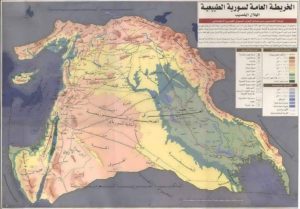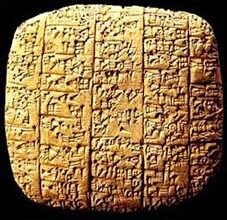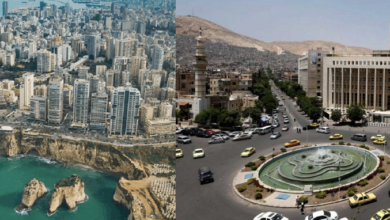المشروع رقم (2): الواقع السياسي وتأثيره على الواقع الاقتصادي في دول الهلال الخصيب
الفكرة الرئيسية لمشروع بحث جامعي في الاقتصاد السياسي
تحديدات أولية
1 ــ الفكرة الرئيسية: دراسة تأثير العامل السياسي في الوضع الاقتصادي، استناداً إلى معطيات الجغرافيا السياسية والمناهج السياسية، للدول المعنية بالبحث.
2 ــ المجال المدروس: العراق ــ الجمهورية العربية السورية ــ الأردن ــ لبنان. يمكن دراسة علاقة دولتين بشكل تفصيلي كنموذج. (يفترض ملاحظة الوضع الاستثنائي لفلسطين).
3 ــ المجال الزمني: المرحلة الممتدة بين 1940 التاريخ الذي بدأت هذه الدول فيه تتهيأ لنيل استقلالها الوطني، والعام 2000 الذي يؤشر على وضع جديد لهذه الدول، سياسياً واقتصادياً.
4 ــ المستند الرئيسي للبحث: البيانات الإحصائية والرقمية للخط ونتائجها التي تم تطبيقها في تلك الدول، واستناد هذه الخطط إلى واقع ورؤية سياسية محددة. والأحداث الكبرى وتأثيراتها على خطط هذه الدول.
ــ أ ــ
قد يكون بحث تأثير العامل السياسي في الوضع الاقتصادي من الأبحاث الكلاسيكية في علم الاقتصاد السياسي، وخصوصاً من جهة المنهج العام الذي يحكم مثل هذه الأبحاث. حيث تتم صياغة التحديدات الخاصة بالوضع الاقتصادي استناداً إلى ما يوفره العامل السياسي من معطيات وأولاها تلك المتعلقة بالجغرافيا السياسية، وثانيها تلك الناتجة من النهج السياسي في فلسفته العامة التي تنطوي على اتجاهات وقوانين محددة وخاصة.
إلا أن ما يضفي الروح الدينامية على الطابع الكلاسيكي للبحث، هو ذلك التصميم الخاص «للمنهج العام» الذي سيتم اعتماده، بما يؤدي افتراضاً، إلى اكتشاف عناصر إضافية وجديدة في العلاقة ما بين العامل السياسي والوضع الاقتصادي، لم تكن واضحة سابقاً أو على الأقل لم يكن ظاهراً تأثيرها الحقيقي ومستوى فاعليتها وأهميتها.
ويكون من نتائج اكتشاف هذه العناصر الجديدة، الشروع في صياغة خارطة جديدة للوضع الاقتصادي، يمكن الاعتماد عليها في رسم تصورات ومخططات جديدة أيضاً، بما يدفع هذا الوضع قدماً نحو الأمام.
وعلى ذلك، فإذا كانت العناصر الجديدة توفر نظرة مختلفة للخارطة الجيوــ سياسية في تبدلاتها وتقلباتها الماضية كما في توضّعها الراهن، فإنها أيضاً وبدرجة أكثر أهمية تساعد على قراءة مستقبل هذه الخارطة واتجاه حركتها وآفاقها، وهذه القراءة تمنح هذا البحث، غالباً، صفة البحث المستقبلي.
ــ ب ــ
تشكل الدول: العراق، الجمهورية العربية السورية، الأردن، لبنان، فلسطين وحدة إقليمية متكاملة تاريخياً. وبعيداً عن استعراض تجليات هذه الوحدة في التاريخ، نرى أنها في القرن العشرين لم يكن لها أي تجلّ أو مؤشر على قيامها وتحققها. وبالمقابل تمت صياغة هذا الإقليم الواحد وفق التقسيم السياسي السابق، المرسوم عام 1916 وفق اتفاقية (سايكس ــ بيكو)، فتم عملياً وبعد هذا التاريخ تجزئة (الواحد) إلى (خمسة)، واحد منهم سيتم استبداله استبدالاً كاملاً في العام 1948 لتحلّ (إسرائيل) مكان (فلسطين)، فتضاف بذلك (حالة سياسية) جديدة إلى الخارطة الإقليمية لها مواصفات ذاتية شديدة الخصوصية ومختلفة في روحها وحركتها واتجاهها اختلافاً جذرياً، بل تناقضياً مع المواصفات الذاتية للحالات (الدول) الأخرى المجاورة.
أدى هذا التقسيم السياسي إلى إنتاج سلسلة من المتغيرات الكبرى طالت الأوضاع الاقتصادية ــ الاجتماعية لتلك الدول كلّها. غير أن هذه الأوضاع الجديدة لم تكن ناتجة من التقسيم بحد ذاته وحسب، بل وبدرجة أكبر من السياسات أو النهوج السياسية التي اتبعتها تلك الدول طوال هذه الحقبة.
بمعنى آخر، أدى تعدد الدول السياسية مع اعتمادها نهوج سياسية مختلفة وبعددها تماماً، إلى تغيرات هيكلية اقتصادية ــ اجتماعية، فجاءت هذه المتغيرات في كل واحدة من هذه الدول وكأنها غير معنية بما يحصل في جوارها تماماً. وحدوث ذلك لم يكن لأسباب عقلانية واضحة ومبررة، أي لأسباب متعلقة بمصير ومستوى المتغيرات، بل غالباً نتيجة لمقتضيات الرؤية السياسية أو النظام السياسي لكل دولة على حدا، بما أدى إلى إيجاد مناخات صراعية ليست بكل الحالات مناخات تنافسية صحيّة وطبيعية تهدف لتحقيق المكاسب انطلاقاً من تقديم الأفضل والأميز والأكثر حداثة.
غير أن ذلك لا يعني أن هذه الدول كانت تتمتع بأنظمة مستقلة بالمعنى الحقيقي، بل كانت كلّها، وحتى أواخر الثمانينات، منضوية في إطار نظام القطبية الثنائية الدولي الذي ميّز تلك الحقبة المعروفة بحقبة الحرب الباردة. وإن كنا نلحظ عند بعضها النزوع لتكوين حالة مستقلة وخاصة، إلا أنها في النهاية تندرج كحالة في معادلة النظام الثنائي العالمي.
ومما يزيد في تعقيد الأمور أن بعض هذه الدول لم تكن تشكّل فيما بينها وحدة أو حتى حداً أدنى من التنسيق العام رغم انضوائها في إطار أحد القطبين، بل وفي معظم الأحيان سادت علاقتها بعضها مع الآخر القطيعة التامة (مثل: العراق والجمهورية العربية السورية، الدولتين المحسوبتين في وقت من الأوقات على خانة الاتحاد السوفييتي).
وبوجه الإجمال لم ترتق العلاقات بين هذه الدول إلى مرحلة العلاقات الاستراتيجية المتميزة بثبات الاتجاه العام ووحدته، وإن كانت هنالك لحظات استراتيجية ميزت هذه العلاقات أثناء بعض الحروب التي نشبت بين بعض هذه الدول (لبنان ــ سورية ــ الأردن) و(إسرائيل).
ــ ج ــ
مهما يكن من أمر توضّع الخارطة الجيوــ سياسية لهذه الدول، يمكن التعبير عن أثرها وتأثيرها في الخارطة الاقتصادية كما يلي:
[[ثمة انزياح كامل ونهائي أحياناً، وجزئي في أحيان أخرى لمسار الحركة الاقتصادية ودورتها واتجاهها، بحيث أخرجها هذا الانزياح عن مسارها الطبيعي ليضعها في مسار آخر يتحكم فيه العامل السياسي الناتج من معطيات الجغرافيا ــ السياسية والنهج السياسي في آن.]]
واستناداً إلى ذلك، فإن وظيفة البحث تتحدد في اكتشاف وتعيين المقدار الحقيقي لهذه الإزاحة من جهة، والنتائج الحاصلة عنها وما ستؤول إليه مستقبلاً من جهة أخرى.
ومن أجل ذلك، فإنه لا بدّ من تتبع مسار الدورات الاقتصادية لكل من الدول المعنية بالبحث، وذلك في الفترة (1940 ــ 2000) في ضوء تأثير العامل السياسي، وذلك للتمكّن من صياغة خارطة مسار هذه الدورات في محطاتها الأساسية التي تعبّر عنها الأنشطة الاقتصادية المختلفة الصناعية والزراعية والتجارية.. الخ.
وهذه الخارطة ستكشف بوضوح مقدار ونتائج الإزاحة التي طالت مسار الدورات الاقتصادية وحركتها والمراكز الأساسية فيها ومواطن المشاريع الكبرى ومجالاتها ومداها، والمناطق المقتولة الحركة فيها. إن هذه الاكتشافات المحددة التي تتوضح من خلال البيانات الرياضية والإحصائية، من شأنها إضفاء صفة الدينامية لهذه الخارطة، الأمر الذي يسمها بالمستقبلية.
الجهة التي يمكن أن تتبنى المشروع:
المشروع موجّه بالدرجة الأولى إلى طلاّب الدراسات العليا الجامعية، ففي اتساعه يمكن أن يكون مشروع أطروحة لنيل شهادة الدكتورة، أما إن تم اختزال مجاله لدراسة حالة دولة واحدة، يمكن أن يكون مشروع أطروحة لنيل شهادة الماجستير.
مع ذلك، يمكن لأي مركز بحث سياسي / استراتيجي، الاستفادة منه جزئياً أو كلياً. كما بالطبع يمكن للمنظمات السياسية والاقتصادية تبني فكرته الرئيسية في برامجها، واقتراحه على حكومات الدول المعنية للوصول إلى أدق النتائج العلمية الممكنة، التي تشكل مرجعية موثوقة في بناء الاستراتيجيات المستقبلية.

Preliminary Limitations
- The main idea:
Studying the effect of the political factor on the economic situation with reference to given politico-geographical data, and the political directions concerned in this research.
- The scope of study:
Iraq, The Syrian Arab Republic, The Jordan, The Lebanon. It is possible to study the relation between any two countries in detail, as an example.
- The Time scope of study:
The period between 1940, the year when these countries started preparing to gain their independence, and 2000, which points to a new political and economic stage for these countries.
- The research’s main references:
The statistical data of the plans implemented in these countries and their consequent results, taking into consideration the fact that these plans are based on these countries’ specific political reality and orientation.
– A –
It may be true that the study of the effect of the political factor on the economic situation is considered to be a classical type of research in the science political economy, especially with view to the general research methodology which govern such studies, and where the limitations concerning the economic situation are formulated according to what the political factor provides. Paramount among these are those related to political geography, and those resulting from the general philosophy of the particular political direction followed, which includes its own specific laws and orientations.
However, what bestows a spirit of dynamism upon the classical nature of such research is the special design of the ’’general research methodology,’’ adopted here, and which, it is hypothesized, will lead to the discovery of additional, and new, elements in the relation between the political factor and the economic situation. Such elements have not been clear in the past, or at least their influence and the degree of their effectiveness have not been apparent.
One of the results of discovering these new elements is the initiation of a re-drawing of a new map for the economic situation, which can be depended upon for new (economic) plans and visions. This will push the economic situation forward. Thus, it these new elements provide a different view of the geo-political map in its various changes and vicissitudes in the past, compared to its state at the present time, then they will help, in an important way, in reading the future of this map, its scope and its evolutionary direction. This ’’reading,’’ then, invariably, characterizes the research as being projective, or futuristic.
– B –
The following countries: Iraq, The Syrian Arab Republic, The Jordan, The Lebanon and Palestine constitute, historically, one regional complementary entity. However, and without concerning ourselves with discussing the various manifestations of this one entity in history, we can see that, in the twentieth century, there is no manifestation or even an indication that it has ever existed. In contrast, this one entity was redesigned in accordance with a previous political partitioning plan, drawn in 1916, as stated in the Sykes-Picotagreement. After this date, this “one entity” was practically divided into “five”, one of which would be entirely replaced in 1948, when “Israel” would occupy the place of “Palestine”. Thus, a new political “status quo” was added to the regional map; a status quo which had its own very special characteristics, and which was not only drastically different in its spirit, orientation and direction, but was also contridactory to the specific characteristics of the other neighboring states.
This political division generated a series of fundamental charges which affected the socio-economic situations of all thoses countries. These new situations, however, were not the result of the policies or the political directions which those countires followed during this era.
Put differently, the increase in the number of political entities (countries), with each adopting a different political approach, lead to structural socio-economic changes. These changes took place in each of these countries as though it was not concerned with what was happening in the neighbouring countries. This non-concern (fo the neighbouring sisterely countries) was not for clear, rational and justified reasons, i.e. for reasons relating to the purpose or level of these socio-economic changes. On the contrary, most often this was the result of the specific political vision or the political system of each separate country, which led to an atmosphere of strife and struggle. This was no always an atmosphere of healthy and natural competition, which aimed at achieving the best, most excellent and most modern results for the people of that country.
This does not mean, however, that these countries enjoyed independent systems of governement, in the real sense of the word. They were all, until the late eighties, enmeshed in the political dual polarity of East and West—known as the cold war—which characterized that era. Altough attempts to establish specifically non-allied states can be seen in some fo these countries, they were all, ultimately, part and parcel of the equation in a world of dual polarity.
What makes matters even more complicated is that some of these countries did not constitute a unity amongst themselves; they did not even have a minimum level of coordination in general matters, despite their revolving within the same sphere of influence of the same pole. In fact, most of the time, total estrangement prevailed in their relations (e.g. Iraq and The Syrian Arab Republic, the two countries, which were counted, at one time, as affiliates of the Soviet Union).
The relations amongst these countries have not, generally speaking, reached the level of strategic ties distinguished by the steadiness and unification of their general direction, even though there have been brief strategic times which distinguised these relations during some of the wars that erupted between a number of these countries (Lebanon, Syria, and Jordan) and Israel.
– C –
Whatever the position of the geo-political map of these countries, its influence and effect on the economic map can be expressed as follows:
“There has been a complete and, sometimes, final, as well as partial, deflection of the course of the economic movement and its cycle and direction so as to push it off its natural track, and place it on another track, controlled by the political factor resulting from, at one and the same time, politico-geographic properties, as well as the particular political direction adopted.”
Thus, and in the light of what has been said so far, this research concerns itself with, on the one hand, the discovery and measurement of the actual size of this deflection; and, on the other, the consequences resulting from it, and how these are expected to develop in the future.
To achieve this end, it is necessary to do a longitudinal study of the courses of the economic cycles in each of the countries covered in this study, in the light of the influence of the political factor, in the period stretching between 1940 -2000. This is so that it becomes possible to map the course of these cycles through their ‘main stations’ as expressed by the various activites: economic, industrial, agricultural, trade, etc. Such a map will reveal clearly the size and the results of the deflection which affected the course of these economic cycles, their movement, and their main centres; the sites of major projects, their scopes and ranges; as well as the areas made lifeless. These specific discoveries, which will be made clear through mathematical and statistical data, bestows upon this map a dynamic attribute that characterizes it by being projective, or futuristic.




” اذا كُنّا عاجزين عن توحدين أوروبا فلنسعى إلى أوروبا أكثر إنتظاما فيما بيننا” شارل ديغول.
الهلال الخصيب هو الحضن الحاضن لوحدة المجتمع المقيم فيه. وغياب هذه الوحدة عن التفاعل الحضاري مع شعوب الأرض طوال الألف سنة الماضية ،واستمرار غياب هذه الوحدة في القرن الواحد والعشرين ؛ أدَّى إلى حالة بالغة الخطورة في التفاعل الدولي ، تنذر بحرب عالمية ثالثة ، يمكننا وصف هذه الحالة الخطيرة بتعبير مجازي وهو : إنَّ قَبٌَان التفاعل الدولي تنقصه بيضة القبَّان.
إن مشروع درااسة ” الواقع السياسي وتأثيره على الواقع الإقتصادي في دول الهلال الخصيب” ، هو خطوة واقعية وعملية ومهمة لتظهير صورة جليَّة لمقدار ترابط موارد الحياة والنمو والتّحضُّر في حوض الهلال الخصيب.
وأود أن أقترح عليكم أن تشمل هذه الدراسة فيما تشمل ، واقع الحال في جنوب غرب الهلال الخصيب كما هو منذ ١٩٤٠ وحتى يومنا هذا. وذلك يساعد في فهم مقدار ما يمكن تحقيقه من نمو في مختلف جوانب المعرفة ، وهي خلقين القوة في اي مجتمع، حين تتبدل العقلية التي تدير استثمار الجغرافيا ذاتها .
وباتوفيق ودوام السعي الى الأفضل.
د عبدالله ضو
– مؤسس الهندسة المتطورة للجزيرة العائمة.
– مصمم وباني، في لبنان، أول جزيرة عائمة في تاريخ العالم.
– مؤلف وباحث في الفكر الاستراتيجي وتطور الحضارات.
شكراً جزيلاً لرأيكم العلمي المحكم، وآمل أن تتبنى جهة ما هذا المشروع بما فيه إضافتكم،
حضوركم أعطى قيمة مضافة لمضمون المشروع
تحياتي